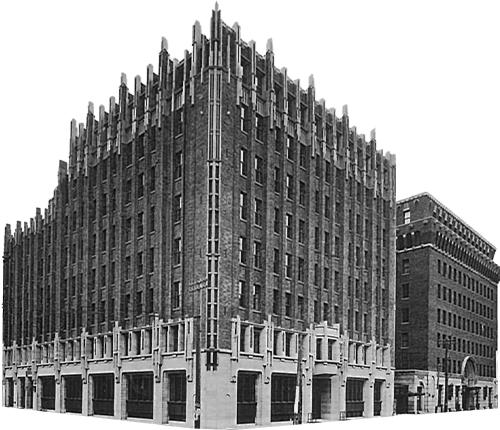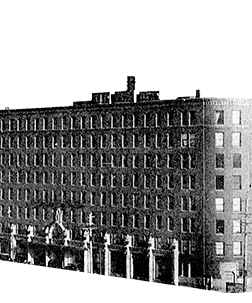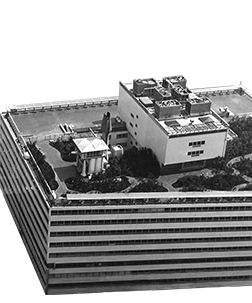 02
1927 1931
02
1927 1931
Tokyo
Hibiya Daibiru Buildings
No. 1 and No. 2
Early Expansion to Tokyo Through Aggressive Management Policies
Preparations in Anticipation of Business Expansion
On October 21, 1925, immediately after the opening of the Daibiru-Honkan Building, the Daibiru Corporation’s Board of Directors passed a resolution to “purchase 550 tsubo (1,818 m) of land for construction of the Tokyo Office at 1-3 Uchisaiwai-cho, Kojimachi-ku, Tokyo, for a price not exceeding 800 yen per tsubo (3.3 m2).” This shows that the original intent of the acquisition was to open a Tokyo Office. The purpose was to establish a new business center in Tokyo due to the fact that the Tokyo branch of O.S.K. Lines had been destroyed by the Great Kanto Earthquake. At the same time, Daibiru strongly desired to expand into Tokyo, the nation’s capital, as soon as possible, and this would explain the resolution at the Board meeting. However, Daibiru was experiencing circumstances at the time that can only be described as dire. The Daibiru-Honkan Building opened on October 1, but the Japanese economy was stagnant, and the Great Kanto Earthquake of September 1, 1923, had a further devastating impact. The decision to expand into Tokyo was made in anticipation of future business expansion and as a strategic move. Even though Daibiru was founded in Osaka, it recognized that business development in Tokyo, Japan’s largest market, was inevitable.
So what kind of neighborhood was Uchisaiwai-cho, Kojimachi-ku, Tokyo, where Daibiru acquired its property? Back during the Edo period, this neighborhood was home to several samurai residences, and the land purchased by Daibiru belonged to a samurai residence of the Koriyama Domain’s Yanagisawa clan. The Yanagisawa clan was one of the most prominent families of the Edo shogunate. The best known member of the family was probably Yanagisawa Yoshiyasu, a famous samurai who became a favorite official of Tsunayoshi, the fifth Tokugawa shogun. His descendants became lords of Koriyama and established this samurai residence.
During the Meiji period (1868–1912), the Koriyama Yanagisawa clan’s Tokyo residence was confiscated to establish the Tokyo Prefectural Office. Eventually, the entire area was put up for auction, and Mitsubishi won the bidding to acquire the property. Daibiru acquired that property in two phases in 1925 and 1926. By that time, the Uchisaiwai-cho area had been devastated by the Great Kanto Earthquake.
Kojimachi Ward eventually became Chiyoda Ward, and how it got its name is an interesting story. There is a theory that Kojimachi was originally named after the various alleys (koji ) in the area. Another theory says that a rice malt (koji ) vendor named Sanshiro Kojiya who handled rice malt for the shogunate lived there, and yet another theory says that the entrance to the Kokufu-kaido Highway that ran from the Kokufu section of Fuchu to Edo (Tokyo) was located in this area, earning it the name “Edo Koji” (meaning “Edo National Road”). Recent excavations have revealed a number of hand-dug chambers called muro that were used for making miso and rice malt at the sites of former manors in this area, so it might have been an actual rice malt production center.
That’s the story behind the historic site that Daibiru selected for its first steps into Tokyo.
-
1927 1931 Hibiya Daibiru Buildings
No. 1 and No. 2 -
2007 International Operations
-
- An Unexpected Discovery of a Good Property
- Mutual Trust and a Long-Term Perspective as Points of Agreement
- The Acquisition of a Property in Hanoi Through Unity of Philosophy
- Implementing Daibiru Quality Through Building Renovations
- Challenges in Australia, Our Second Overseas Expansion Target
- The Discovery of 275 George Street
- Difficult Contract Negotiations with JHG
- Overcoming Several Unexpected Difficulties
-



